Solar eclipse of February 16, 1980
A total solar eclipse occurred on February 16, 1980. A solar eclipse occurs when the Moon passes between Earth and the Sun, thereby totally or partly obscuring the image of the Sun for a viewer on Earth. A total solar eclipse occurs when the Moon's apparent diameter is larger than the Sun's, blocking all direct sunlight, turning day into darkness. Totality occurs in a narrow path across Earth's surface, with the partial solar eclipse visible over a surrounding region thousands of kilometres wide. The path of totality crossed central Africa, southern India, and into China at sunset. The southern part of Mount Kilimanjaro, the highest mountain in Africa, also lies in the path of totality. Occurring only about 24 hours before perigee (Perigee on February 17, 1980), the Moon's apparent diameter was larger.
| Solar eclipse of February 16, 1980 | |
|---|---|
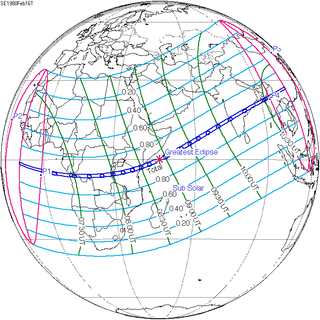 Map | |
| Type of eclipse | |
| Nature | Total |
| Gamma | 0.2224 |
| Magnitude | 1.0434 |
| Maximum eclipse | |
| Duration | 248 sec (4 m 8 s) |
| Coordinates | 0.1°S 47.1°E |
| Max. width of band | 149 km (93 mi) |
| Times (UTC) | |
| Greatest eclipse | 8:54:01 |
| References | |
| Saros | 130 (50 of 73) |
| Catalog # (SE5000) | 9464 |
Related eclipses
Solar eclipses of 1979–1982
This eclipse is a member of a semester series. An eclipse in a semester series of solar eclipses repeats approximately every 177 days and 4 hours (a semester) at alternating nodes of the Moon's orbit.[1] There were 8 solar eclipses between February 26, 1979 and July 20, 1982. Were there: February 26, 1979 (total solar eclipse, 0.8 days after perigee, 103.9%, 0.89811 gamma, saros 120), August 22, 1979 (small annular solar eclipse, 0.6 days before apogee, 93.3%, -0.96319 gamma, saros 125), February 16, 1980 (total solar eclipse, 1 day before perigee, 104.3%, 0.22244 gamma, saros 130), August 10, 1980 (large annular solar eclipse, 5 days before apogee, 97.3%, -0.19154 gamma, saros 135), February 4, 1981 (large annular solar eclipse, 4 days before perigee, 99.4%, -0.48375 gamma, saros 140), July 31, 1981 (total solar eclipse, 3.8 days after perigee, 102.6%, 0.57917 gamma, saros 145), January 25, 1982 (moderate partial solar eclipse, 4.7 days after apogee, 56.6%, -1.23110 gamma, saros 150) and July 20, 1982 (small partial solar eclipse, 0.9 days after perigee, 46.4%, 1.28859 gamma, saros 155).
| Solar eclipse series sets from 1979–1982 | ||||||
|---|---|---|---|---|---|---|
| Descending node | Ascending node | |||||
| Saros | Map | Gamma | Saros | Map | Gamma | |
| 120 | 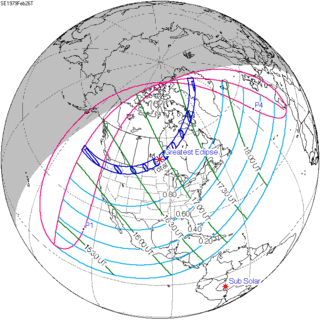 1979 February 26 Total | 0.89811 | 125 | 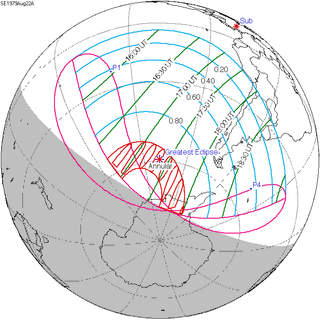 1979 August 22 Annular | -0.96319 | |
| 130 |  1980 February 16 Total | 0.22244 | 135 | 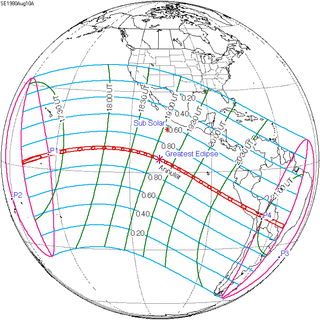 1980 August 10 Annular | -0.19154 | |
| 140 | 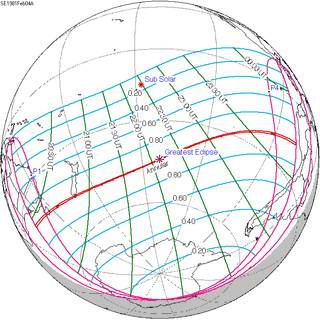 1981 February 4 Annular | -0.48375 | 145 | 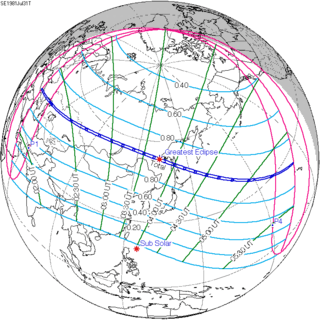 1981 July 31 Total | 0.57917 | |
| 150 | 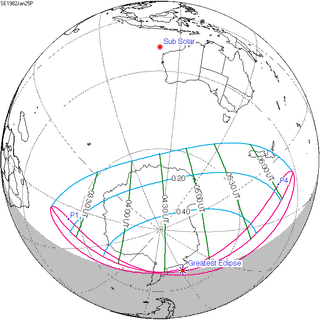 1982 January 25 Partial | -1.23110 | 155 |  1982 July 20 Partial | 1.28859 | |
| Partial solar eclipses on June 21, 1982 and December 15, 1982 occur in the next lunar year eclipse set. | ||||||
Saros 130
This eclipse is a part of Saros cycle 130, repeating every 18 years, 11 days, containing 73 events. The series started with partial solar eclipse on August 20, 1096. It contains total eclipses from April 5, 1475 through July 18, 2232. There are no annular eclipses in the series. The series ends at member 73 as a partial eclipse on October 25, 2394. The longest duration of totality was 6 minutes, 41 seconds on July 11, 1619. All eclipses in this series occurs at the Moon’s descending node.[2]
| Series members 43–56 between 1853 and 2300 | ||
|---|---|---|
| 43 | 44 | 45 |
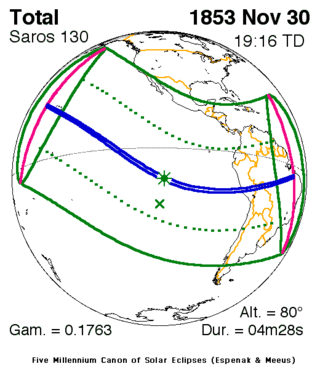 November 30, 1853 |
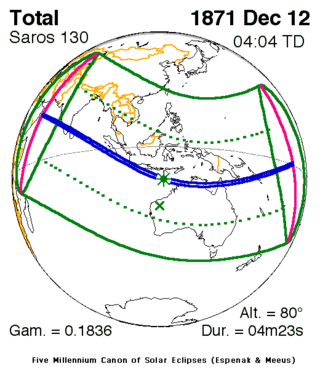 December 12, 1871 |
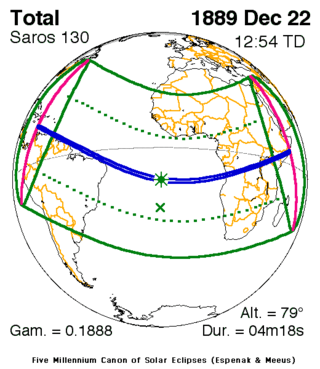 December 22, 1889 |
| 46 | 47 | 48 |
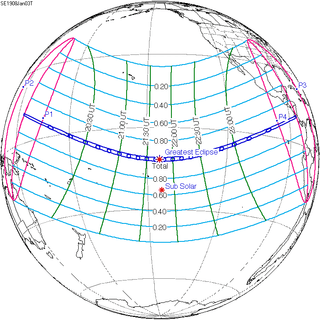 January 3, 1908 |
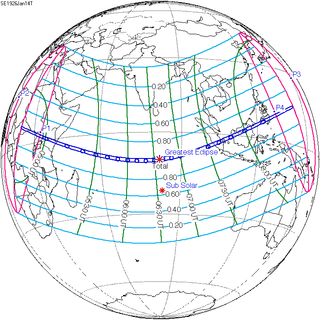 January 14, 1926 |
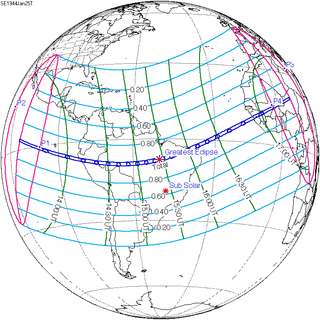 January 25, 1944 |
| 49 | 50 | 51 |
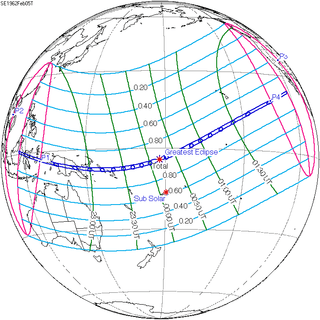 February 5, 1962 |
 February 16, 1980 |
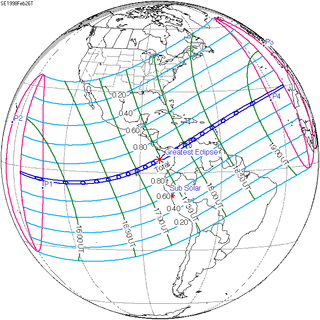 February 26, 1998 |
| 52 | 53 | 54 |
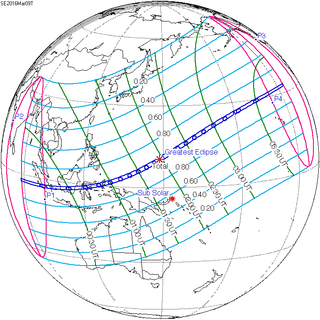 March 9, 2016 |
 March 20, 2034 |
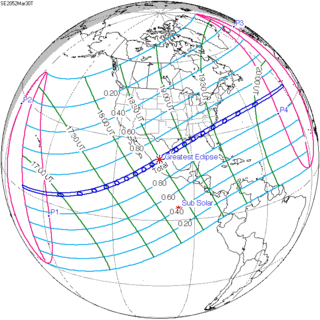 March 30, 2052 |
| 55 | 56 | 57 |
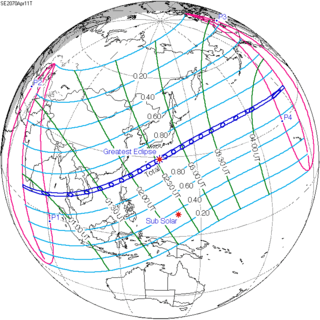 April 11, 2070 |
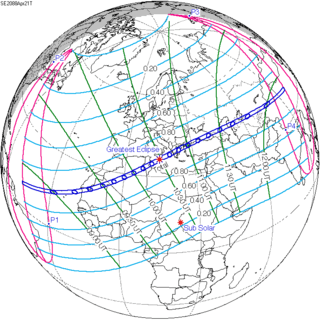 April 21, 2088 |
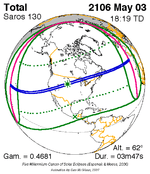 May 3, 2106 |
| 58 | 59 | 60 |
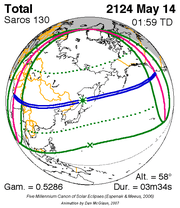 May 14, 2124 |
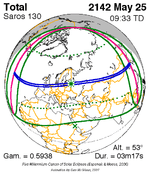 May 25, 2142 |
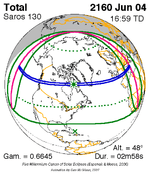 June 4, 2160 |
| 61 | 62 | 63 |
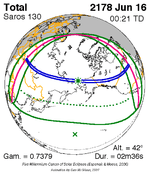 June 16, 2178 |
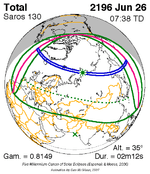 June 26, 2196 |
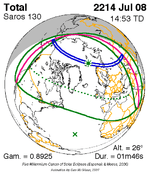 July 8, 2214 |
| 64 | 65 | 66 |
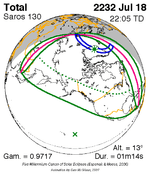 July 18, 2232 |
 July 30, 2250 |
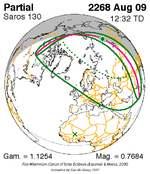 August 9, 2268 |
| 67 | ||
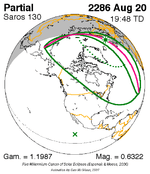 August 20, 2286 | ||
Tritos series
This eclipse is a part of a tritos cycle, repeating at alternating nodes every 135 synodic months (≈ 3986.63 days, or 11 years minus 1 month). Their appearance and longitude are irregular due to a lack of synchronization with the anomalistic month (period of perigee), but groupings of 3 tritos cycles (≈ 33 years minus 3 months) come close (≈ 434.044 anomalistic months), so eclipses are similar in these groupings.
| Series members between 1901 and 2100 | |||
|---|---|---|---|
 September 21, 1903 (Saros 123) |
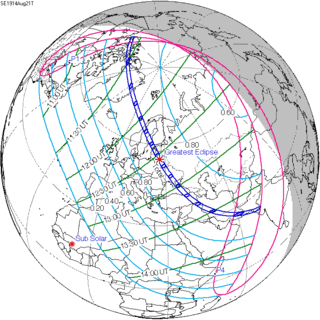 August 21, 1914 (Saros 124) |
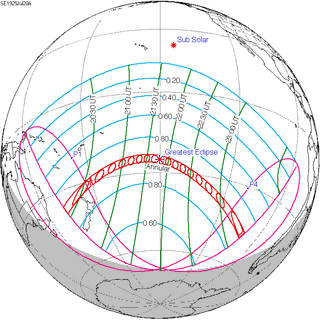 July 20, 1925 (Saros 125) | |
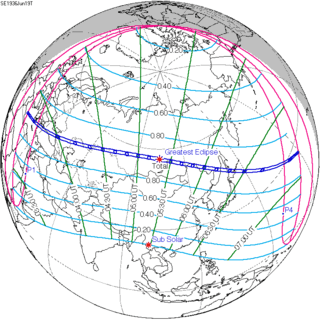 June 19, 1936 (Saros 126) |
 May 20, 1947 (Saros 127) |
 April 19, 1958 (Saros 128) | |
 March 18, 1969 (Saros 129) |
 February 16, 1980 (Saros 130) |
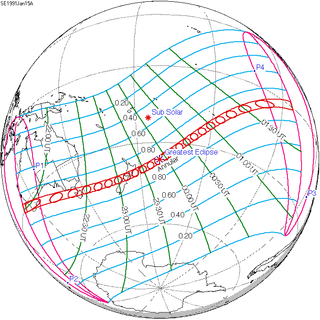 January 15, 1991 (Saros 131) | |
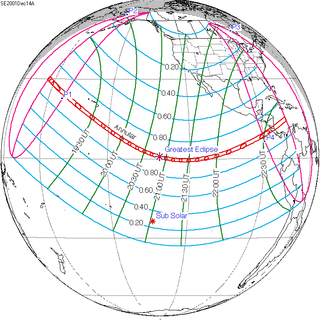 December 14, 2001 (Saros 132) |
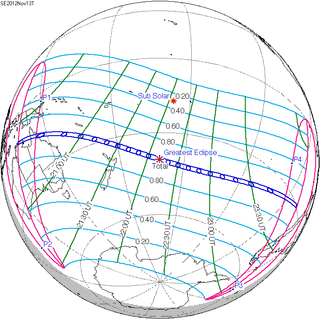 November 13, 2012 (Saros 133) |
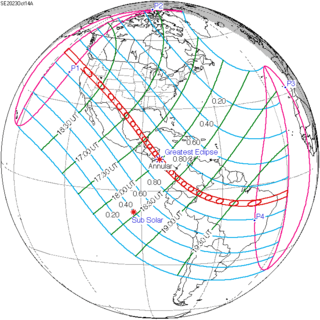 October 14, 2023 (Saros 134) | |
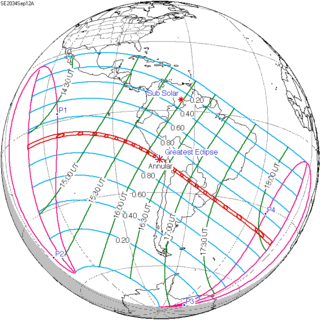 September 12, 2034 (Saros 135) |
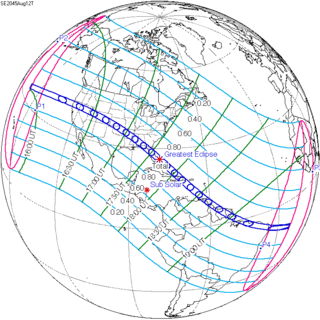 August 12, 2045 (Saros 136) |
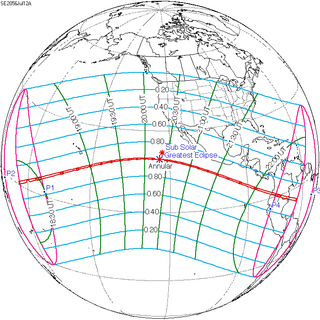 July 12, 2056 (Saros 137) | |
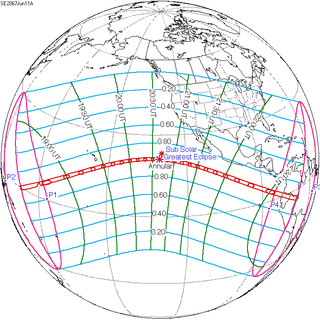 June 11, 2067 (Saros 138) |
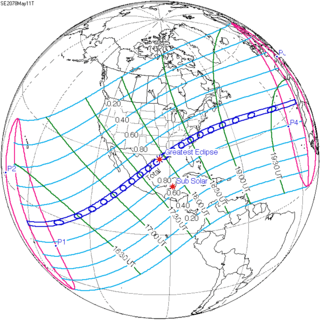 May 11, 2078 (Saros 139) |
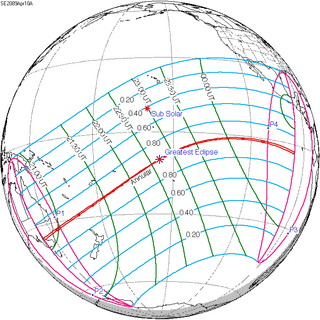 April 10, 2089 (Saros 140) | |
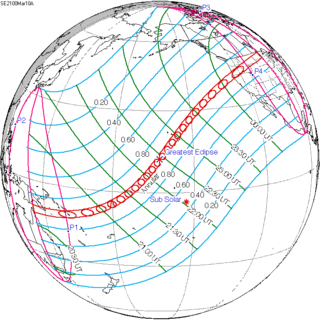 March 10, 2100 (Saros 141) |
|||
Metonic series
The metonic series repeats eclipses every 19 years (6939.69 days), lasting about 5 cycles. Eclipses occur in nearly the same calendar date. In addition, the octon subseries repeats 1/5 of that or every 3.8 years (1387.94 days). All eclipses in this table occur at the Moon's descending node.
| 21 eclipse events, progressing from north to south between July 11, 1953 and July 11, 2029 | ||||
|---|---|---|---|---|
| July 10–12 | April 29–30 | February 15–16 | December 4–5 | September 21–23 |
| 96 | 98 | 100 | 102 | 104 |
| July 12, 1915 | April 30, 1919 | February 15, 1923 | December 5, 1926 | September 22, 1930 |
| 106 | 108 | 110 | 112 | 114 |
| July 11, 1934 | April 30, 1938 | February 15, 1942 | December 4, 1945 | September 22, 1949 |
| 116 | 118 | 120 | 122 | 124 |
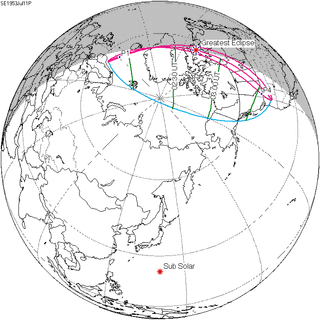 July 11, 1953 |
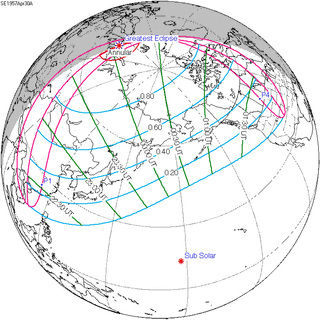 April 30, 1957 |
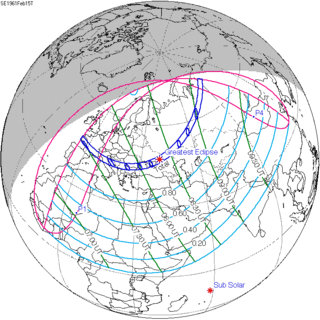 February 15, 1961 |
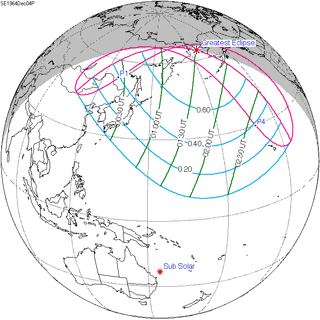 December 4, 1964 |
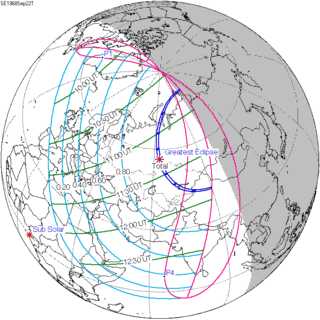 September 22, 1968 |
| 126 | 128 | 130 | 132 | 134 |
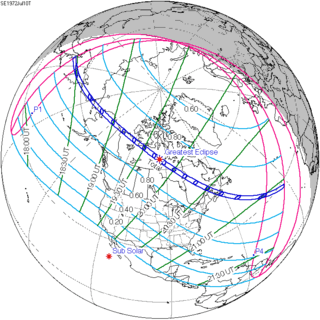 July 10, 1972 |
 April 29, 1976 |
 February 16, 1980 |
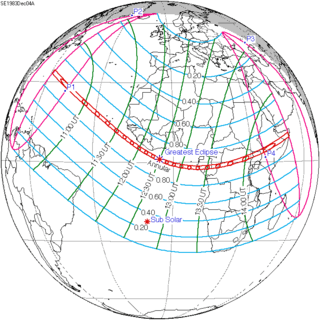 December 4, 1983 |
 September 23, 1987 |
| 136 | 138 | 140 | 142 | 144 |
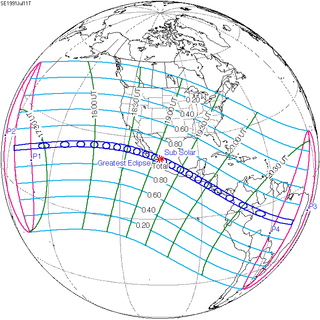 July 11, 1991 |
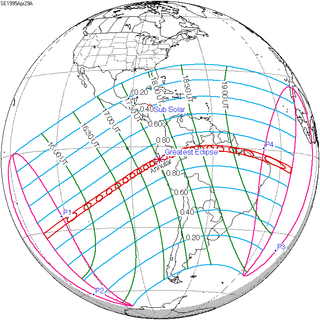 April 29, 1995 |
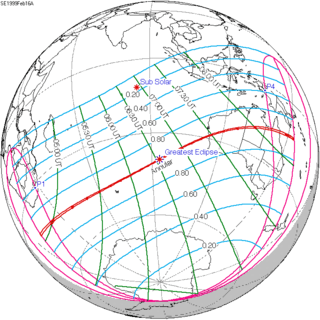 February 16, 1999 |
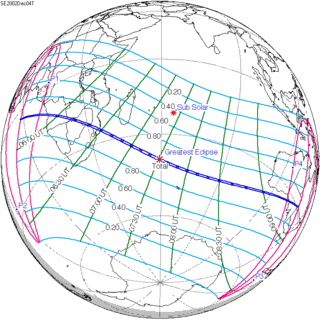 December 4, 2002 |
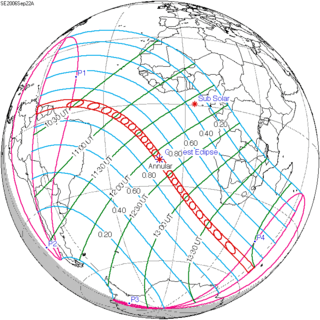 September 22, 2006 |
| 146 | 148 | 150 | 152 | 154 |
 July 11, 2010 |
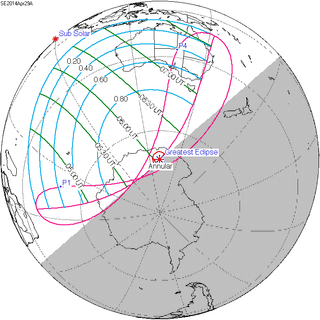 April 29, 2014 |
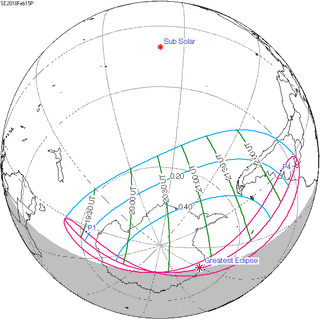 February 15, 2018 |
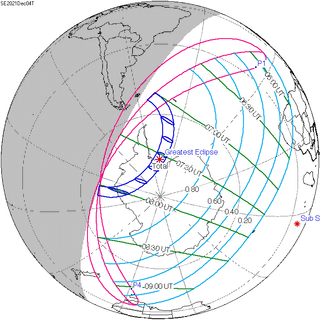 December 4, 2021 |
 September 21, 2025 |
| 156 | 158 | 160 | 162 | 164 |
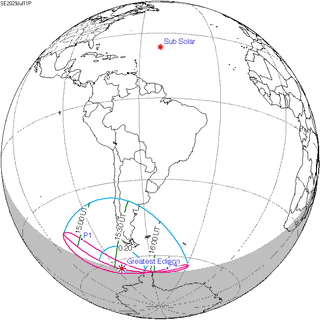 July 11, 2029 |
April 29, 2033 | February 15, 2037 | December 4, 2040 | September 21, 2044 |
Notes
- van Gent, R.H. "Solar- and Lunar-Eclipse Predictions from Antiquity to the Present". A Catalogue of Eclipse Cycles. Utrecht University. Retrieved 6 October 2018.
- "Saros Series catalog of solar eclipses". NASA.
.jpg)
